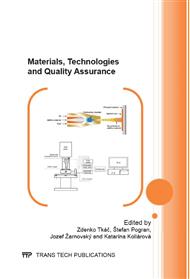[1]
M. Kotus, Z. Andrássyová, J. Žitňanský, M. Bujna, P. Žúbor, Surface welding of seedbed cultivator shares with a shielding gas, Acta Technologica Agriculturae. 14(4) (2011) 110-112.
Google Scholar
[2]
M. Bujna, P. Čičo, M. Kotus, F. Kolenič, Vplyv kompozitných práškových materiálov na zvýšenie úžitkových vlastností radličiek pri naváraní laserom, Acta Mechanica Slovaca. 12(4-B) (2008) 35-39.
Google Scholar
[3]
P. Čičo, M. Bujna, F. Kolenič, Zvýšenie úžitkových vlastností radličiek laserovým naváraním kompozitných práškových materiálov, In: Kvalita a spoľahlivosť technických systémov, SUA in Nitra, Nitra, 2008, pp.115-120.
Google Scholar
[4]
P. Čičo, M. Kotus, M. Bujna, Údržba a oprava strojov, SUA in Nitra, 2013, ISBN 978-80-552-1019-3.
Google Scholar
[5]
G. Staneva, Pl. Kangalov, L. Stanev, Wear resistance of recovered parts with phosphate conversion coating of sliding friction, PB at Angel Kanchev University of Ruse, Ruse, 46 (2007) 62-66.
Google Scholar
[6]
G. Krastev, Pl. Kangalov, Research on the rate of coating iron with Hull cell, PB at Angel Kanchev University of Ruse, Ruse, 45 (2006) 45-48.
Google Scholar
[7]
J. Vetter et al., Surface treatment selections for automotive applications, Surface and Coatings Technology. 200 (2005) 1962-1968.
DOI: 10.1016/j.surfcoat.2005.08.011
Google Scholar
[8]
M. Žernovič, R. Mikuš, Tribological properties of powder hard surfaced layers, In: International Science Conference of Materials Science and Manufacturing Technology : book of papers, CULS Prague, Prague, 2007, pp.144-146.
Google Scholar
[9]
I. Kováč, J. Žarnovský, J. Žitňanský, Vrstvy odolné proti opotrebeniu, In: New Trends in Technology System Operation : proceedings of the seventh conference with international participation, Prešov, TU of Košice, Košice, 2005, pp.160-161.
Google Scholar
[10]
R. Mikuš, I. Kováč, R. Drlička, D. Hudec, Tribologické vlastnosti dvojvrstvových práškových tvrdonávarov, In: Kvalita a spoľahlivosť technických systémov, Nitra, 2012, pp.155-160.
Google Scholar
[11]
ISO 9227: 2007, Corrosion tests in artificial atmospheres – Salt spray tests. ICS: 77.060, p.23
Google Scholar
[12]
ISO 10289: 2003, Methods for corrosion testing of metallic and other inorganic coatings on metallic substrates. Rating of test specimens and manufactured articles subjected to corrosion tests, ICS: 25.220.20, 25.220.40, p.22
DOI: 10.3403/02219291
Google Scholar


